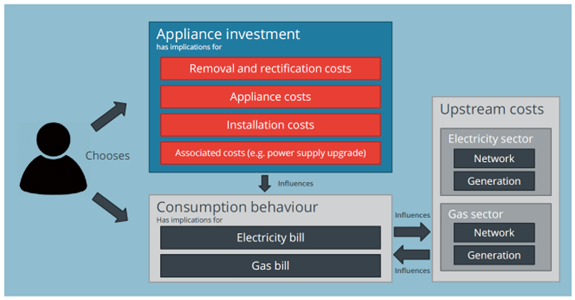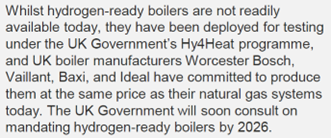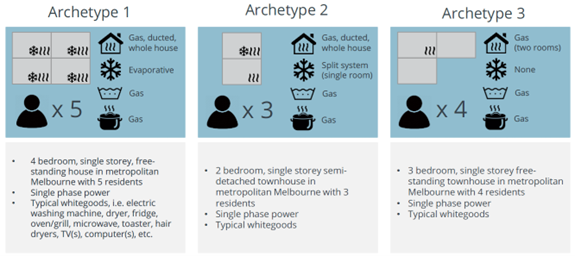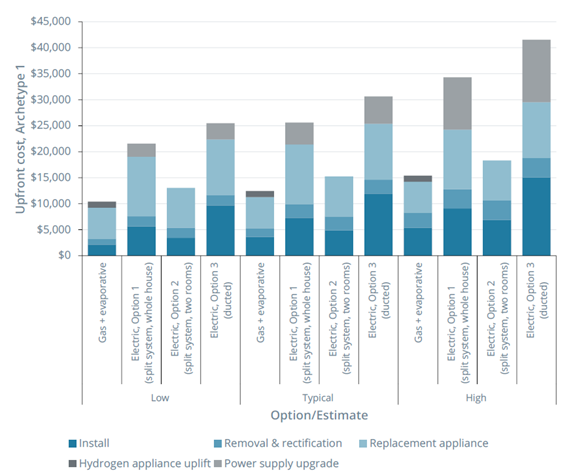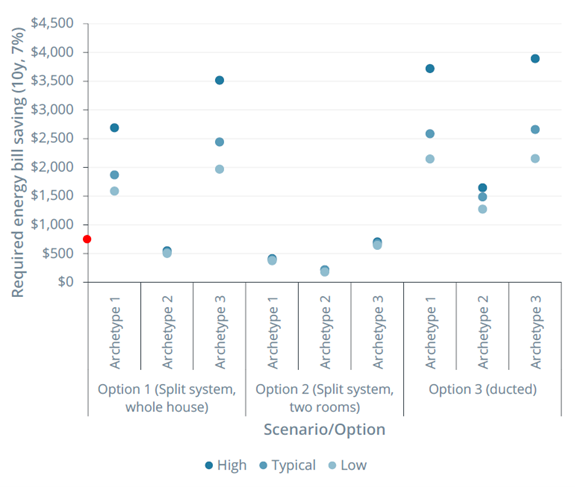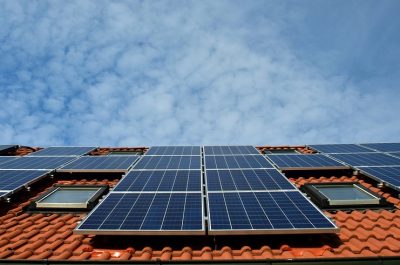Revealing the hidden costs of electrification
Many government incentive programs claim bill savings by making the switch from gas appliances to electric ones. These claims are often simplistic and commonly based on appliance purchase costs, government subsidies and retail prices.
In many cases, the running cost of the electric appliances is assumed to be free by linking it to rooftop solar. However, on a cold winter’s evening when the sun isn’t shining another form of dispatchable power will be required. The Victorian Government’s Energy Upgrades[1] scheme is one program offering rebates to switch to an all-electric home while promising future savings on power bills. But if there truly are savings to be made in switching to all electric homes, why are government incentives needed?
Appliance replacement costs for households
A new study[2] from Frontier Economics for the Gas Appliance Manufacturers Association of Australia (GAMAA) compares the upfront costs that households using gas will face if they electrify their energy compared with the upfront costs of continuing to use gas appliances. The study focusses on appliance investment options and considers the impact on energy bills.
Figure 1: Context of the study (Source: Frontier Economics (2022), Cost of switching from gas to electric appliances in the home1)
The upfront costs included in the GAMAA study include:
- The cost of removing existing appliances, including any rectification work that might be required, such as covering existing ducts, plastering, and painting. These costs are mostly excluded in earlier studies.
- The cost of purchasing new appliances. Frontier Economics assumed that newly installed gas appliances would be hydrogen compatible and this would incur an increase of 30 per cent on the capital cost. However, UK gas appliance manufacturers have committed to produce hydrogen-ready boilers at the same price as natural gas ones today. So, the assumption made by Frontier Economics favours electrification.
Source: Energy & Utilities Alliance (2021), The Upfront cost of decarbonising your home, pg 8
- The cost of installing new appliances, including labour and materials.
- The cost of electricity supply upgrade, if this is required because of the new electrical appliances.
Source: Gas Vision 2050 (2020), Delivering a Clean Energy Future, pg 8
Data on the upfront costs was collected from appliance installers for both a replacement of gas with gas appliances option or a replacement with electric appliances. Three options were considered with the electrical appliance replacement.
- Option 1: Heat pump split systems capable of heating and cooling the whole house (either multiple single splits or one multi-split unit).
- Option 2: A heat pump split system capable of heating and cooling a living area and master bedroom (either multiple single splits or one multi-split unit).
- Option 3: A ducted heat pump capable of heating and cooling the whole house.
The appliance installers were also asked to consider the costs in different building types.
Figure 2: Building archetypes used in the study (Source: Frontier Economics)
The findings were presented for each building archetype and replacement option, as illustrated in Figure 3.
Figure 3: Up front costs for appliance replacements for Archetype 1 (Source: Frontier Economics)
It is noticeable that the option to replace gas appliances with hydrogen ready appliances is the cheapest option, even with a 30 per cent uplift in capital price of gas appliances. The electrical appliance and installation costs for whole of house heating are much higher than gas and also require an upgrade to the electricity supply system. The option where only a few rooms in the house are heated appears slightly more expensive than the gas option but does not have the benefit of whole of house heating as provided in the gas option.
Bringing it back to bills
Given the higher upfront costs of electrical appliances, Frontier Economics estimated the required bill savings to offset this cost.
Figure 4: Required energy bill savings with a discount rate of 7 per cent over 10 years (Source: Frontier Economics) (NOTE: Typical VGSR bill savings shown by red dot)
Given the wide range in cost estimates across the different archetypes and appliance options, the energy bills savings also vary widely. For reference, the estimated bill saving noted in Victoria’ Gas Substitution roadmap was $740 per year. This is shown by the red dot in Figure 4. The details of how those savings have been calculated are unclear but it is understood that a significant part of that relates to switching from ducted heating to only heating a few rooms in the home, and this loss of amenity would drive major energy and hence bill reductions. As can be seen from Figure 4, the average of required energy bill savings to justify the additional expense for electrification is much higher than the generous bill savings estimated in the VGSR.
The findings of this analysis suggest the additional upfront cost to Victorian consumers of replacing their existing gas appliances with electric appliances, compared to replacing them with new gas appliances capable of burning hydrogen gas, varies significantly based on the level of amenity required. If all Victorian homes were to only attempt to heat and cool two major rooms of their home (Option 2), upfront costs for the state of electrification of households could be as low as $4 billion. This however provides less heating than homes have now. If, however, whole of home heating and cooling is required (Options 1 and 3), the cost is likely to increase to a figure in the region of $14 to $31 billion.
Conclusion
Bill savings are often promised as a major benefit for electrification. But these savings do not fully account for appliance costs, changes in retail energy prices and other factors such as retrofitting costs or required electricity meter upgrades.
When those broader costs are included, and when the systems cost savings are considered, it is cheaper to stay with gas appliances, even when allowing a higher appliance cost to have a hydrogen ready gas appliance.
[1] https://engage.vic.gov.au/victorian-energy-upgrades-space-heating-and-cooling-activities
[2] https://gamaa.asn.au/wp-content/uploads/2022/07/Frontier-Economics-Report-GAMAA.pdf
[3] https://www.energynetworks.com.au/resources/reports/2020-reports-and-publications/gas-vision-2050-delivering-a-clean-energy-future/
